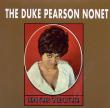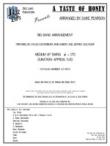HI-FLY
Arranged by Duke Pearson, Prepared by Dylan Canterbury, Rob DuBoff, and Jeffrey Sultanof

Cat #: JLP-7760
$85.00This item usually ships within 1 business day.
Questions?
Please call +1-518-587-1102 or email us.
Edition: Jazz Big Band Arrangement
Description: Swing - Difficult
Publisher: Jazz Lines Publications
Duke Pearson's interpretation of Randy Weston's classic tune Hi-Fly was almost completely unknown to the general listening public for years. Thankfully, a recent release of a 1969 concert of Pearson's big band in Baltimore has brought this wonderful arrangement to light. The arrangement does not feature any particularly difficult rhythmic or melodic figures, but is a bit of a long blow for the brass section.
The arrangement begins, as this tune so often does, with a slow rubato version of the melody's bridge. Pearson's arrangement has an almost chorale-like quality to it, and should be approached accordingly. The melody proper begins at measure 9, where the tempo also kicks in. The first two A sections are handled by a pair of duos; first, two trumpets, followed by two flutes. The backgrounds underneath are largely sustained tones. The full ensemble comes together at measure 25 for another chorale-like reading of the bridge, followed by a broken up bugle-like re-working of the final A section at measure 33.
A quick ensemble fanfare sets up a tenor saxophone solo at measure 41. There are some gently prodding backgrounds during the first chorus, while the backgrounds under the final chorus at measure 106 gradually grow in both volume and punch until climaxing at measure 130. The tenor soloist gets a break for a joyful ensemble half-chorus shout section at measure 138, followed by one final half-chorus solo salvo at measure 154. The spotlight shifts to a trumpet solo at measure 170, with a similar (but not identical) set of growing backgrounds coming in at measure 203.
The arrangement's final chorus kicks off at measure 235. As before, this shout section should have an overall jubilant, even triumphant feel to it. The bridge at measure 251 marks the return of the chorale-like beginning (albeit in tempo this time), as well as the beginning of a slow but consistent tapering off of volume until the end of the arrangement. A militaristic but subdued brass fanfare at measure 273 set up a final woodwind flourish four measures later before the somewhat surprising final chord, where the melody is hinted at one last time by flutes and muted trumpets.
This publication is not a transcription - it has been prepared from the original parts used during the 1969 live performance. Both alto saxophones double on flute.
2 Alto Saxophones (Both Double Flute)
2 Tenor Saxophones
Baritone Saxophone
4 Trumpets
4 Trombones
Guitar (Optional)
Piano
Bass
Drums
Trombone 1: C5








